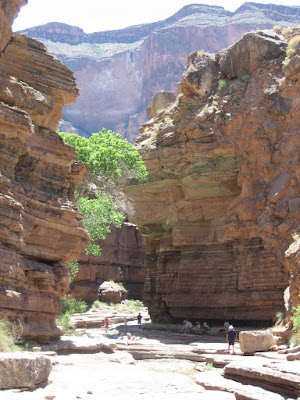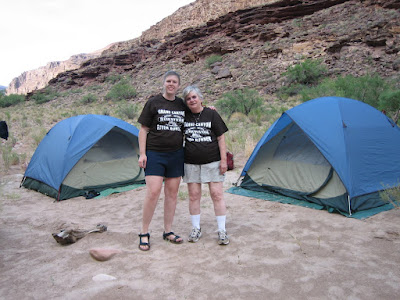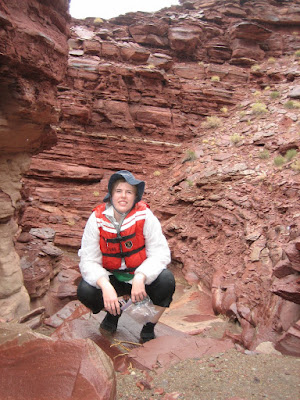 Mom and Jan opted not to, Mom remembering better than me that there was a lot of bouldering involved. It will always be one of my favorite places. I climbed around the back and jumped off, but only once because the water was cold! First thing in the morning. And it remains very precarious to get up the back. Like I’ve done it the past 2 trips and Beth Purdy was still having to instruct me how to maneuver myself up. Jumping is not nearly as scary as climbing up the back :P
Mom and Jan opted not to, Mom remembering better than me that there was a lot of bouldering involved. It will always be one of my favorite places. I climbed around the back and jumped off, but only once because the water was cold! First thing in the morning. And it remains very precarious to get up the back. Like I’ve done it the past 2 trips and Beth Purdy was still having to instruct me how to maneuver myself up. Jumping is not nearly as scary as climbing up the back :P  We hiked back to the boat and rafted another hour or two, and stopped at the Doll’s House. We climbed around and looked at dubendorf(?) rapid that was right ahead. I somehow remember it being more fun and easier to climb- possibly because I was chasing Randy and Bo around last time. Also I chose poorly in a climb and had to have Bruce coach me down a bit from a rock.
We hiked back to the boat and rafted another hour or two, and stopped at the Doll’s House. We climbed around and looked at dubendorf(?) rapid that was right ahead. I somehow remember it being more fun and easier to climb- possibly because I was chasing Randy and Bo around last time. Also I chose poorly in a climb and had to have Bruce coach me down a bit from a rock.  Then I finally climbed through to the beach to pee and look at the rapid, and was trying to take pictures of lizards when I heard Mark and other calling me back to the raft. So I hightailed it back and we were on the river again.
Then I finally climbed through to the beach to pee and look at the rapid, and was trying to take pictures of lizards when I heard Mark and other calling me back to the raft. So I hightailed it back and we were on the river again. 
 This was probably the easiest hike, completely flat through a shallow creek to a pretty and slightly larger than we’d yet seen waterfall. It was warmer water and great to stand in and get group pictures J
This was probably the easiest hike, completely flat through a shallow creek to a pretty and slightly larger than we’d yet seen waterfall. It was warmer water and great to stand in and get group pictures J 


 I will say that the pictures of people look more recognizable when they are slightly in front of the waterfall instead of actually in it, but in it is way more fun :)
I will say that the pictures of people look more recognizable when they are slightly in front of the waterfall instead of actually in it, but in it is way more fun :) A few more miles and we were at Deer Creek. Mom and the Karmas and Jan stayed at the bottom and hung out at the enormous waterfall, and about half of our group including myself hiked up to the patio. This is a steep hike that is a lot of fun, requiring hands a lot for balance. It’s a lot of hiking up, but there is a great view at the top of the river, and that’s not the end.
A few more miles and we were at Deer Creek. Mom and the Karmas and Jan stayed at the bottom and hung out at the enormous waterfall, and about half of our group including myself hiked up to the patio. This is a steep hike that is a lot of fun, requiring hands a lot for balance. It’s a lot of hiking up, but there is a great view at the top of the river, and that’s not the end.  Then you walk above a slot canyon that gets shallower as you go, until you can wade in it and sit in the shade at the patio.
Then you walk above a slot canyon that gets shallower as you go, until you can wade in it and sit in the shade at the patio. 
 It had changed a lot since last trip; a rockslide had taken out a bunch of trees that were nice to sit under. Mark, Elizabeth, and Brett or Ben took a nap and I walked over to where I knew Randy had his special piece of wood under a rock… in a boulder field. I should explain. Randy Brown was a friend from the previous two trips (I think he had been on seven total) that passed away from cancer about a year and a half ago. He had this piece of wood that he would engrave his trip dates on every time he went to deer creek. Elizabeth and I had talked about it at the beginning of the trip and thought about trying to find it. Since neither Elizabeth or I knew at all where it was, it was immediately obvious when I got to Deer creek that we would never find it. Which was okay. It was good being there just the same, and Randy would have wanted the wood to stay in it’s spot.
It had changed a lot since last trip; a rockslide had taken out a bunch of trees that were nice to sit under. Mark, Elizabeth, and Brett or Ben took a nap and I walked over to where I knew Randy had his special piece of wood under a rock… in a boulder field. I should explain. Randy Brown was a friend from the previous two trips (I think he had been on seven total) that passed away from cancer about a year and a half ago. He had this piece of wood that he would engrave his trip dates on every time he went to deer creek. Elizabeth and I had talked about it at the beginning of the trip and thought about trying to find it. Since neither Elizabeth or I knew at all where it was, it was immediately obvious when I got to Deer creek that we would never find it. Which was okay. It was good being there just the same, and Randy would have wanted the wood to stay in it’s spot. 
 If you stand in the spray, you can see a full circle rainbow around you in the powerful mist. This is one waterfall I had no desire to swim under- waaay too big.
If you stand in the spray, you can see a full circle rainbow around you in the powerful mist. This is one waterfall I had no desire to swim under- waaay too big.
>After enjoying the giant falls I headed back to the raft and found our group, and within 10-15 minutes we were on our way to a campsite literally a mile downstream.
 It was called Pancho’s kitchen. I think it took like 2 hours for the sun to go down and our campsite to be in the shade. I forget if I washed my hair that night, having bathed the night before, but I did some laundry in the river and hung it nicely on sticks in the rocks in the ledge. We had Italian I think, (this is the guides cooking dinner)
It was called Pancho’s kitchen. I think it took like 2 hours for the sun to go down and our campsite to be in the shade. I forget if I washed my hair that night, having bathed the night before, but I did some laundry in the river and hung it nicely on sticks in the rocks in the ledge. We had Italian I think, (this is the guides cooking dinner) and birthday cake since it was Pat’s birthday.
and birthday cake since it was Pat’s birthday.  We were also told that the boatmen really liked our group and were going to try to get us to Matkatimiba the next day although it would be pushing it; we'd pack our lunches in the morning to save time.
We were also told that the boatmen really liked our group and were going to try to get us to Matkatimiba the next day although it would be pushing it; we'd pack our lunches in the morning to save time.  So it was a nice evening in camp, (I don't remember who ducktaped Matthew, but it was bound to happen at some point)- I slept on a little bit of an incline to get away from the snoring in our group, but it was so nice to see the stars and the bats as I went to sleep.
So it was a nice evening in camp, (I don't remember who ducktaped Matthew, but it was bound to happen at some point)- I slept on a little bit of an incline to get away from the snoring in our group, but it was so nice to see the stars and the bats as I went to sleep.






























